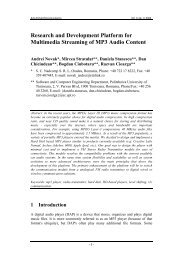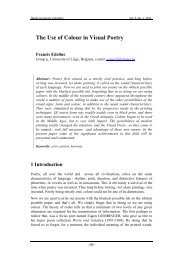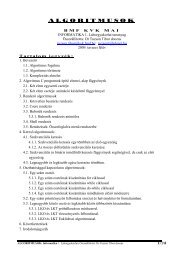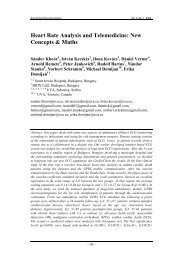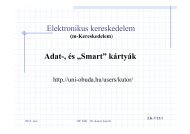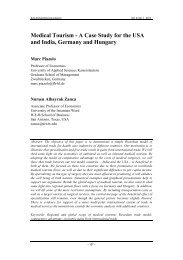RTOS Program Models Used in Embedded Systems
RTOS Program Models Used in Embedded Systems
RTOS Program Models Used in Embedded Systems
Create successful ePaper yourself
Turn your PDF publications into a flip-book with our unique Google optimized e-Paper software.
Óbuda University e‐Bullet<strong>in</strong> Vol. 2, No. 1, 2011<br />
<strong>RTOS</strong> <strong>Program</strong> <strong>Models</strong> <strong>Used</strong> <strong>in</strong> <strong>Embedded</strong><br />
<strong>Systems</strong><br />
József Kopják, Dr. János Kovács<br />
Kandó Kálmán Faculty of Electrical Eng<strong>in</strong>eer<strong>in</strong>g<br />
Óbuda University, Budapest, Hungary<br />
kopjak.jozsef@kvk.uni-obuda.hu<br />
Faculty of Eng<strong>in</strong>eer<strong>in</strong>g Sciences<br />
Széchenyi István University, Győr, Hungary<br />
kovacs@sze.hu<br />
Abstract: The paper present and compare some real-time control program models<br />
used by programmers programm<strong>in</strong>g <strong>in</strong> embedded systems. The paper do not<br />
demonstrate all programm<strong>in</strong>g models, only the most important variations based on<br />
writer's op<strong>in</strong>ion. The writer tried to show the advantages and disadvantages of each<br />
programm<strong>in</strong>g models discussed <strong>in</strong> article. The paper beg<strong>in</strong>s with traditional models<br />
like sequential model, cooperative multitask<strong>in</strong>g and cont<strong>in</strong>ues with timed cooperative<br />
model and f<strong>in</strong>ish with event-driven model.<br />
Keywords: cooperative multitask<strong>in</strong>g; timed cooperative model keyword1; event-driven<br />
model; real-time<br />
1 Introduction<br />
The improvement of microcontrollers us<strong>in</strong>g <strong>in</strong> embedded systems is very strong.<br />
Some performances of microcontrollers are on same level like <strong>in</strong> personal<br />
computers. The tasks of microcontrollers do not stop on control functions. With<br />
higher comput<strong>in</strong>g speed is possible to satiate user demands like to have a<br />
graphical user <strong>in</strong>terface on LCD with touch panel (<strong>in</strong>telligent dish washer) or to<br />
create a connection with server (<strong>in</strong>telligent power meter). To resolve these new<br />
problems programmers needs to have new program model<strong>in</strong>g knowledge.<br />
– 161 –
J. Kopják et al. <strong>RTOS</strong> <strong>Program</strong> <strong>Models</strong> <strong>Used</strong> <strong>in</strong> <strong>Embedded</strong> <strong>Systems</strong><br />
2 Real-Time <strong>Systems</strong><br />
Non real-time system are usually us<strong>in</strong>g <strong>in</strong> office technologies. In non real-time<br />
systems <strong>in</strong>com<strong>in</strong>g events followed each other <strong>in</strong> time <strong>in</strong> a same priority level are<br />
not served <strong>in</strong> a queue followed each other. In these systems are known the average<br />
of process<strong>in</strong>g time of events, but we do not know the maximum time of answer of<br />
occurred event.[1]<br />
Real-time control is very important <strong>in</strong> solutions us<strong>in</strong>g <strong>in</strong> <strong>in</strong>dustrial and medical<br />
environment. Every event has own priority <strong>in</strong> real-time system. Consecutively<br />
becom<strong>in</strong>g events <strong>in</strong> a same priority level are served <strong>in</strong> one after the other. The<br />
maximum of answer time of <strong>in</strong>com<strong>in</strong>g event is known and def<strong>in</strong>ed.<br />
A critical aspect of real-time systems is how time itself is handled. The design of a<br />
real-time system must identify the tim<strong>in</strong>g requirements of the system and ensure<br />
that the system performance is both correct and timely. The three types of time<br />
constra<strong>in</strong>ts on computation are: hard, soft, firm [2].<br />
3 Sequential <strong>Program</strong>m<strong>in</strong>g Model<br />
Sequential programm<strong>in</strong>g models are used <strong>in</strong> <strong>in</strong>dustrial solutions usually.<br />
Sequential programm<strong>in</strong>g model is named l<strong>in</strong>ear programm<strong>in</strong>g model too. These<br />
programs are composed from four software component: <strong>in</strong>itialization, read<strong>in</strong>g<br />
status of the <strong>in</strong>puts, calculation or process<strong>in</strong>g, refresh<strong>in</strong>g values of the outputs.<br />
Figure 1 illustrates the simplified flow chart of program based on sequential<br />
programm<strong>in</strong>g model.<br />
Figure 1<br />
Simplified flow chart of program based on sequential program<strong>in</strong>g model<br />
The advantage of sequential programm<strong>in</strong>g model is the design of program is very<br />
similar to classical logical circuit design method. Simultaneously (<strong>in</strong> time) read<strong>in</strong>g<br />
of all <strong>in</strong>puts and writ<strong>in</strong>g of all outputs exclude the hazard known <strong>in</strong> logical<br />
circuits.<br />
– 162 –
Óbuda University e‐Bullet<strong>in</strong> Vol. 2, No. 1, 2011<br />
The disadvantage of the model is <strong>in</strong> case of writ<strong>in</strong>g of complex programs the<br />
source code will conta<strong>in</strong> lots of if-else control structures and therefore will be<br />
<strong>in</strong>comprehensible. Other disadvantage of the model is the poor utilization of<br />
processor. The program permanently recalculate the values of outputs, regardless<br />
of there is any change on <strong>in</strong>puts. The program based on such a model is still<br />
runn<strong>in</strong>g, therefore uses up the entire CPU time. The reaction time of program<br />
<strong>in</strong>creases with the program complexity due to constant recalculations.<br />
4 Cooperative Multitask<strong>in</strong>g<br />
In cooperative multitask tasks are work<strong>in</strong>g together with each other. The tasks are<br />
simple functions without <strong>in</strong>put parameters and return value. The ma<strong>in</strong> program<br />
first <strong>in</strong>itializes the peripheral devices, after the <strong>in</strong>itialization the program calls the<br />
task functions <strong>in</strong> loop. Figure 2 illustrate the simplified flow chart of program<br />
based on multitask programm<strong>in</strong>g model.<br />
Figure 2<br />
Simplified flow chart of program based on multitask program<strong>in</strong>g model<br />
Source code written <strong>in</strong> cooperative multitask model is more transparent than the<br />
codes written <strong>in</strong> sequential method. The tasks can be easily separated, each task<br />
have different job. These tasks are <strong>in</strong> different functions, and these functions are<br />
located <strong>in</strong> different source files usually. In case the task-functions are located <strong>in</strong><br />
different source files the program developers can be work together easily, because<br />
they don't <strong>in</strong>terfere with each others work. Each developer has to modify only<br />
their own files, and don't need to change content of files created by other<br />
developers.<br />
Follow<strong>in</strong>g piece of C-language source code represents the ma<strong>in</strong> loop responsible<br />
for call<strong>in</strong>g the task functions.<br />
– 163 –
J. Kopják et al. <strong>RTOS</strong> <strong>Program</strong> <strong>Models</strong> <strong>Used</strong> <strong>in</strong> <strong>Embedded</strong> <strong>Systems</strong><br />
<strong>in</strong>t ma<strong>in</strong> ( void )<br />
{<br />
vInitSystem();// Initialization of peripherals<br />
while(1) // Inf<strong>in</strong>itive function call<strong>in</strong>g loop<br />
{<br />
vTask1(); // Call<strong>in</strong>g task function named vTask1<br />
vTask2(); // Call<strong>in</strong>g task function named vTask2<br />
vTask3(); // Call<strong>in</strong>g task function named vTask3<br />
}<br />
}<br />
Develop<strong>in</strong>g source code <strong>in</strong> cooperative multitask model required more preparatory<br />
plann<strong>in</strong>g time than sequential solution. The designer has to divide the whole<br />
program-task to small <strong>in</strong>dividual work<strong>in</strong>g tasks <strong>in</strong> a first phase of development.<br />
Each <strong>in</strong>dividual work<strong>in</strong>g task is communicat<strong>in</strong>g with each other on global<br />
variables or with another name: via mailboxes. The cooperat<strong>in</strong>g task functions<br />
usually read its <strong>in</strong>puts values at the beg<strong>in</strong>n<strong>in</strong>g and writ<strong>in</strong>g they output values at<br />
end of each runn<strong>in</strong>g sequence. The program scans its <strong>in</strong>puts and updates its<br />
outputs values several times dur<strong>in</strong>g a one circle <strong>in</strong> the ma<strong>in</strong> loop.<br />
The task should complete them runn<strong>in</strong>g sequence as soon as possible to got short<br />
program response time. The task should not use block<strong>in</strong>g or wait<strong>in</strong>g loops. Us<strong>in</strong>g<br />
block<strong>in</strong>g loops would drastic <strong>in</strong>cise the response time of runn<strong>in</strong>g system. Some<br />
block<strong>in</strong>g loops examples: Wait<strong>in</strong>g for releas<strong>in</strong>g a push button or wait<strong>in</strong>g for an<br />
UART peripheral register flag. The tasks have to remember the current state of<br />
runn<strong>in</strong>g and return back to the call<strong>in</strong>g function <strong>in</strong> case when a resource is not<br />
available.<br />
The task functions should be structured based on state mach<strong>in</strong>e model due to lack<br />
of a block<strong>in</strong>g waits. In state mach<strong>in</strong>e model the functions are us<strong>in</strong>g static local<br />
variables to store them next states. The backbone of each task function is a switchcase<br />
structure. The task first exam<strong>in</strong>es the value of the state description variable,<br />
and then jumps to the program code of the state. Follow<strong>in</strong>g piece of C-language<br />
source code illustrates the body of task function based on state mach<strong>in</strong>e model.<br />
void vTask( void )<br />
{<br />
/* State description variable. Initial state is:<br />
INIT_STATE */<br />
static enum { INIT_STATE, STATE1, STATE2, STATE3 }<br />
xState = INIT_STATE;<br />
/* Selection of sub-task based on the value of state<br />
variable */<br />
switch ( xState )<br />
{<br />
case INIT_STATE: // Initialization tasks<br />
/* ... */<br />
xState = STATE1; // Selection of next state<br />
break; // End of actual runn<strong>in</strong>g<br />
case STATE1: // First task<br />
/* ... */<br />
xState = STATE2; // Selection of next state<br />
break; // End of actual runn<strong>in</strong>g<br />
/* ... */<br />
default: // Protection state:<br />
– 164 –
Óbuda University e‐Bullet<strong>in</strong> Vol. 2, No. 1, 2011<br />
}<br />
// Normally the program never gets here.<br />
xState = INIT_STATE; // Re<strong>in</strong>itialization of<br />
// task-function<br />
}<br />
The advantage of cooperative multitask model is the possibility of creation quasiparallel<br />
multitask system without us<strong>in</strong>g preemptive multitask operation system.<br />
The disadvantage of cooperative multitask model is the pretension of good<br />
developer programm<strong>in</strong>g skills. The response time of program is depends on the<br />
tasks execution time. The execution time of task is not a constant value, because<br />
every task state has other execution time. The response time of program will be<br />
sw<strong>in</strong>g<strong>in</strong>g, but is possible to calculate the fastest and slowest reaction time of<br />
system. The shortest reaction time of system is the sum of fastest runn<strong>in</strong>g time of<br />
tasks, and the longest response is the sum of slowest runn<strong>in</strong>g time of tasks.<br />
Another disadvantage of the cooperative multitask is that the program is not able<br />
to manage energy consumption of the processor. The processor runs the code<br />
permanently, it cannot go to energy-efficient mode (sleep or idle), this means the<br />
processor will be have maximum energy consumption.<br />
5 Timed Cooperative Multitask<strong>in</strong>g<br />
The basic cooperative multitask model do not deal with time, it means if<br />
somebody would like to create timed functions or events then the programer must<br />
to create own timer to measure the elapsed time. In timed cooperative multitask<br />
model the tasks do not run always like <strong>in</strong> classical cooperative multitask model,<br />
only when they block<strong>in</strong>g or wait<strong>in</strong>g time has expired.<br />
If somebody would like to implement time cooperative multitask model, then he<br />
must create own lightweight kernel to manage the task functions. There is some<br />
known implementation of cooperative multitask<strong>in</strong>g, with other name co-rut<strong>in</strong>s,<br />
like Free<strong>RTOS</strong> . Free<strong>RTOS</strong> is an open source operat<strong>in</strong>g system for embedded<br />
systems written <strong>in</strong> C language[3]. The kernels, what we found, work<strong>in</strong>g with time,<br />
but the time is not the basic element of they kernel model, therefore we design a<br />
own lightweight cooperative multitask kernel.<br />
To demonstrate the difference between classical cooperative multitask<strong>in</strong>g an the<br />
timed cooperative multitask<strong>in</strong>g we made an example program. In our program are<br />
two tasks. The task are runn<strong>in</strong>g quasi-parallel. The mission of each task is very<br />
simple: Invert one output p<strong>in</strong>. Next code example written is C language shows the<br />
implementation of these tasks.<br />
/* Task function of task #1*/<br />
void vTask1 ( void )<br />
{<br />
mTurnOnLED( 3 ); // Turn On LED #3 (The task starts his runn<strong>in</strong>g)<br />
mToogleLED( 1 ); // Toogle LED #1 (The mission of the task)<br />
mTurnOffLED( 3 ); // Turn Off LED #3 (The task stops his runn<strong>in</strong>g)<br />
}<br />
– 165 –
J. Kopják et al. <strong>RTOS</strong> <strong>Program</strong> <strong>Models</strong> <strong>Used</strong> <strong>in</strong> <strong>Embedded</strong> <strong>Systems</strong><br />
/* Task function of task #2*/<br />
void vTask2 ( void )<br />
{<br />
mTurnOnLED( 0 ); // Turn On LED #0 (The task starts his runn<strong>in</strong>g)<br />
mToogleLED( 2 ); // Toggle LED #2 (The mission of the task)<br />
mTurnOffLED( 0 ); // Turn Off LED #0 (The task stops his runn<strong>in</strong>g)<br />
}<br />
Our <strong>in</strong>itial kernel is very simple. Next code example shows our <strong>in</strong>itial, not timed,<br />
kernel.<br />
/* endless loop */<br />
while (1)<br />
{<br />
vTask1(); // Call Task1 function<br />
vTask2(); // Call Task2 function<br />
}<br />
The Figure 3 illustrate the result of program runn<strong>in</strong>g is simulator. In picture you<br />
can f<strong>in</strong>d 4 l<strong>in</strong>es. The l<strong>in</strong>e with label “Task #1” is <strong>in</strong> high level when the task #1 is<br />
runn<strong>in</strong>g, and is <strong>in</strong> low level when the task is “no runn<strong>in</strong>g” state. The l<strong>in</strong>e with<br />
label “Task #2” is demonstrate the actual state of the task #2 (the conditions of<br />
high and low level is similar like <strong>in</strong> previously described l<strong>in</strong>e). L<strong>in</strong>e with label<br />
“PIN #1” and l<strong>in</strong>e with label “PIN #2” shows the output of Task #1 and Task #2<br />
(toggle LEDs on output p<strong>in</strong>s).You can see <strong>in</strong> the figure, that the both tasks are<br />
runn<strong>in</strong>g always <strong>in</strong> circa half of the processors time.<br />
Figure 3<br />
Result of runn<strong>in</strong>g program write <strong>in</strong> traditional cooperative multitask model<br />
To create a timed task call<strong>in</strong>g we need a one timer global timer, who create for as<br />
an cont<strong>in</strong>ues global time <strong>in</strong> tick. Operat<strong>in</strong>g system usually measure the time <strong>in</strong><br />
tick. The tick counter is 16 or 32 bit long unsigned variable, but it can be an 8 bit<br />
counter <strong>in</strong> very small systems. We used 16 bit wide architecture to test our kernel,<br />
therefor our tick counter is 16 wide too. In this example the timer <strong>in</strong>crease the<br />
value of tick counter <strong>in</strong> every one millisecond.<br />
We need an array list too, where are the task descriptors. One element of array is a<br />
structure, which represents one task. The descriptor structure has three fields, the<br />
– 166 –
Óbuda University e‐Bullet<strong>in</strong> Vol. 2, No. 1, 2011<br />
po<strong>in</strong>ter of task function, the recall <strong>in</strong>terval <strong>in</strong> tick and the time stamp of last call.<br />
Next code example shows the declaration of task descriptor structure.<br />
/* Type def<strong>in</strong>e: Task Entry structure */<br />
typedef struct<br />
{<br />
void (*pvTaskPo<strong>in</strong>ter) ( void ); // Poniter of taskfunction<br />
TICK_TYPE tickRecallInterval; // Recall <strong>in</strong>tervall <strong>in</strong> tick<br />
TICK_TYPE tickLastTimeStamp; // Time stamp of last call<br />
} TASK_ENTRY;<br />
Next piece of code shows the list of tasks. The list must be closed with predef<strong>in</strong>ed<br />
clos<strong>in</strong>g entry where the value of function po<strong>in</strong>ter is NULL. In case when the array<br />
is closed with clos<strong>in</strong>g entry the programer do not need to predef<strong>in</strong>e the size of<br />
array list, because the parser part of the program could determ<strong>in</strong>ate the size of<br />
given array.<br />
static TASK_ENTRY xTaskList[] =<br />
{<br />
{vTask1, 3, 0},<br />
{vTask2, 6, 0},<br />
{NULL, 0, 0} // End of Task List (clos<strong>in</strong>g entry)<br />
};<br />
The kernel first calculates the difference of current time and the time stamp of last<br />
call, and when this value is greater than or equal to tasks recall time then calls the<br />
task function. Next piece of code shows the implementation of kernel.<br />
/* Local variables */<br />
TICK_TYPE tickCurrentTime;<br />
HTASK_ENTRY hTask;<br />
UBASE_TYPE uxTaskIndex = 0;<br />
/* endless loop*/<br />
while (1)<br />
{<br />
hTask = &xTaskList[uxTaskIndex++]; // Get handle of task from task list<br />
if( hTask->pvTaskPo<strong>in</strong>ter != NULL )<br />
{<br />
/* If task entry is not clos<strong>in</strong>g entry: */<br />
tickCurrentTime = tickGetCurrentTime(); // Get current time <strong>in</strong> tick<br />
if ( (tickCurrentTime - hTask->tickLastTimeStamp) >= hTask->tickRecallInterval )<br />
{<br />
/* If task time was expired, then task must be called: */<br />
hTask->pvTaskPo<strong>in</strong>ter(); // Call task function<br />
hTask->tickLastTimeStamp = tickCurrentTime; // Write time stamp of last call<br />
}<br />
}<br />
else<br />
{<br />
uxTaskIndex = 0; // Restart loop counter<br />
}<br />
}<br />
The Figure 4 illustrate the result of program runn<strong>in</strong>g is simulator. In picture you<br />
can f<strong>in</strong>d 4 l<strong>in</strong>es. The mean<strong>in</strong>g of the l<strong>in</strong>es are same like <strong>in</strong> Figure 3.You can see <strong>in</strong><br />
the figure, that the both tasks are runn<strong>in</strong>g only when they block<strong>in</strong>g time is expired.<br />
– 167 –
J. Kopják et al. <strong>RTOS</strong> <strong>Program</strong> <strong>Models</strong> <strong>Used</strong> <strong>in</strong> <strong>Embedded</strong> <strong>Systems</strong><br />
Figure 4<br />
Result of timed cooperated multitask<strong>in</strong>g<br />
6 Event-driven <strong>Program</strong>m<strong>in</strong>g Model<br />
Before analyz<strong>in</strong>g the event-driven programm<strong>in</strong>g model let's look at the concept of<br />
the event. The event is an occurrence (<strong>in</strong>cidence), which may change the status an<br />
object [4].The events are signals from the outside of world <strong>in</strong> generally. Events are<br />
describ<strong>in</strong>g dynamic changes of <strong>in</strong>puts. Events can be external -hardware- events<br />
such as a button press or a tank becomes full or <strong>in</strong>ternal -software- events such as<br />
queue is full or semaphore was taken.<br />
The objects be<strong>in</strong>g <strong>in</strong>formed about events through messages. The message <strong>in</strong><br />
complex, distributed system can be objects too, such as a communications packet<br />
(MODBUS message or TCP / IP packet). In s<strong>in</strong>gle-processor systems we are us<strong>in</strong>g<br />
a simple function calls to transmit the messages.<br />
In traditional event-driven model based programs are only passive objects. The<br />
objects recalculates they output values do the effect of change they <strong>in</strong>put values.<br />
The event-driven program runs only when the <strong>in</strong>put values are chang<strong>in</strong>g. The<br />
response time of program depend on the number of chang<strong>in</strong>g <strong>in</strong>put values <strong>in</strong> same<br />
time, and do not depend on the controlled network complexity.<br />
The traditional event-driven system consists the follow<strong>in</strong>g actors:<br />
Interrupt service rout<strong>in</strong>es (ISR) - The processors <strong>in</strong>terrupt periphery calls the<br />
<strong>in</strong>terrupt service rout<strong>in</strong>es <strong>in</strong> case of external or <strong>in</strong>ternal <strong>in</strong>terrupt event. Hardware<br />
<strong>in</strong>terrupt can be a change of the value of <strong>in</strong>put p<strong>in</strong> (Interrupt On Change),<br />
<strong>in</strong>com<strong>in</strong>g data on communication port or end of data transmission. Internal<br />
hardware event can be a timer overflow or end of analog-digital conversion. The<br />
<strong>in</strong>terrupt service rout<strong>in</strong>es create event-telegrams, which are posted to event queues<br />
by ISRs.<br />
– 168 –
Óbuda University e‐Bullet<strong>in</strong> Vol. 2, No. 1, 2011<br />
Event-telegraphs - The event-data structures consist of a m<strong>in</strong>imum of two parts:<br />
The signal of the event conveys the type of the occurrence, and event parameters<br />
convey the quantitative <strong>in</strong>formation about the occurrence [5]. Follow<strong>in</strong>g piece of<br />
C-language source code illustrates example for event-telegraph structure.<br />
typedef struct EventTag<br />
{<br />
unsigned <strong>in</strong>t uiEventID; // Event ID<br />
unsigned <strong>in</strong>t uiParam; // Event parameter<br />
} Event;<br />
Event queue - Event queue is a list (first <strong>in</strong> first out type list) of event telegraphs.<br />
The <strong>in</strong>terrupt service rout<strong>in</strong>es put the event telegraphs to the end of queue and the<br />
event handler loop gets events from queue. Care should be taken when<br />
implement<strong>in</strong>g the event queue because is shared resource. The event telegraphs<br />
arrive to the queue asynchronously. All operation with event queue should be<br />
made <strong>in</strong> critical section; exclude multiple writes, or read and write, <strong>in</strong> queue <strong>in</strong><br />
same time.<br />
Event message process<strong>in</strong>g loop - The event message process<strong>in</strong>g loop located <strong>in</strong><br />
the ma<strong>in</strong> program. The event message process<strong>in</strong>g loop is an <strong>in</strong>f<strong>in</strong>ite loop. The loop<br />
first tries to get message for event queue. If there is a wait<strong>in</strong>g message <strong>in</strong> the<br />
queue, then the loop process it based on message ID and message parameters. If<br />
there is no message wait<strong>in</strong>g to be processed, then the loop puts the processor to<br />
the power sav<strong>in</strong>g mode. The <strong>in</strong>terrupts will be wake up the processor from powersav<strong>in</strong>g<br />
mode.<br />
Not only the <strong>in</strong>terrupt service rout<strong>in</strong>es can put events to the queue, but the event<br />
process<strong>in</strong>g loop too. It can be happens the actual event process<strong>in</strong>g ends with<br />
generation of new event. In such cases, the generated event is added to the end of<br />
the queue of events. Figure 5 illustrates the traditional event-driven program<br />
structure.<br />
Figure 5<br />
Traditional event-driven program structure<br />
Event-driven systems require a dist<strong>in</strong>ctly different way of th<strong>in</strong>k<strong>in</strong>g than traditional<br />
sequential programs [5]. The event-driver program do not wait for an external<br />
event, the program react to events [6]. The program must be designed <strong>in</strong> if-then<br />
conditions, for example: if the set p<strong>in</strong> of set-reset flip-flop change to true, then the<br />
– 169 –
J. Kopják et al. <strong>RTOS</strong> <strong>Program</strong> <strong>Models</strong> <strong>Used</strong> <strong>in</strong> <strong>Embedded</strong> <strong>Systems</strong><br />
output of flip-flop must be set to true; if the reset p<strong>in</strong> of set-reset flip-flop change<br />
to true, then the output of flip-flop must be set to false.<br />
The structure of event process<strong>in</strong>g loop is similar to the functions developed basis<br />
on state-mach<strong>in</strong>e model. The core of loop is an switch-case structure. The switch<br />
tag jumps to the selected function description based on <strong>in</strong>com<strong>in</strong>g event ID.<br />
Follow<strong>in</strong>g piece of C-language sample code illustrates the body of event<br />
process<strong>in</strong>g loop.<br />
while(1)<br />
{<br />
/* Gett<strong>in</strong>g event from event queue */<br />
if( xQueueReceive( xEventQueue, &xReceivedEvent, 0 )<br />
== pdPASS )<br />
{ // On successful reception:<br />
/* Jump to selected task based on message ID */<br />
switch ( xReceivedEvent.uiEventID )<br />
{<br />
case BUTTON: // The button has bean sent<br />
/* ... */ // the message<br />
break; // End of message process<strong>in</strong>g<br />
}<br />
case TIMER: // The timer has bean sent<br />
/* ... */ // the message<br />
break; // End of message process<strong>in</strong>g<br />
}<br />
else // There is no event wait<strong>in</strong>g to be processed:<br />
{<br />
Idle(); // The processor goes to power sav<strong>in</strong>g mode<br />
}<br />
The advantage of program based on traditional event-driven model is that the<br />
model <strong>in</strong>cludes the automatic control of processor power consumption. If the<br />
message comes when the event queue is empty the response time of program is<br />
the message process<strong>in</strong>g plus the answer generation time. The disadvantage is that<br />
the program can not rank events based on their importance and is not suitable to<br />
create modular program.<br />
Conclusions<br />
All programm<strong>in</strong>g models presented here have their own reason for existence. For<br />
smaller tasks may be useful to use design models presented at the beg<strong>in</strong>n<strong>in</strong>g of the<br />
article, for complex systems are better solutions described <strong>in</strong> the second half of the<br />
article. Complex models are us<strong>in</strong>g more processor for adm<strong>in</strong>istrative tasks <strong>in</strong>stead<br />
of real problem, thereby reduc<strong>in</strong>g the effectiveness of the processor. On battery<br />
powered solutions should be used solution where the models automatically<br />
manage the processors energy consumption.<br />
References<br />
[1] József Kopják – Dr. János Kovács, Event-driven control program models<br />
runn<strong>in</strong>g on embedded systems, 2011<br />
[2] Bruce Powel Douglass, Real-Time UML: develop<strong>in</strong>g efficient objects for<br />
embedded systems, 1998<br />
[3] Richard Barry, Us<strong>in</strong>g The Free<strong>RTOS</strong> Real Time Kernel, 2009<br />
– 170 –
Óbuda University e‐Bullet<strong>in</strong> Vol. 2, No. 1, 2011<br />
[4] Angster Erzsébet, Az Objektumorientált tervezés és programozás alapjai, 1997<br />
[5] Miro Samek, Practical UML Statecharts <strong>in</strong> C/C++, Second Edition, 2009<br />
[6] Dr. Kondorosi Károly, Dr. László Zoltán, Dr. Szirmay-Kalos László,<br />
Objektum-Orientált Szoftverfejlesztés, 2003<br />
– 171 –






